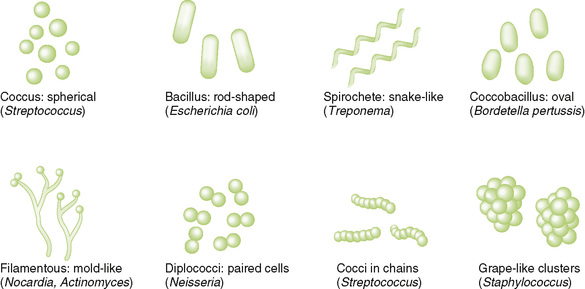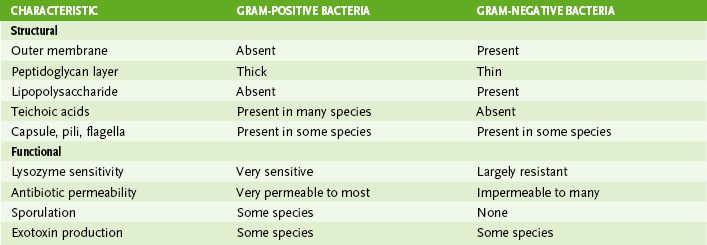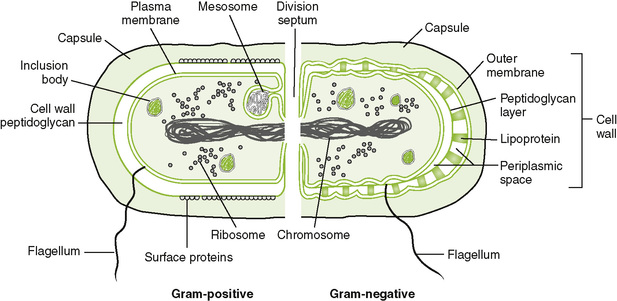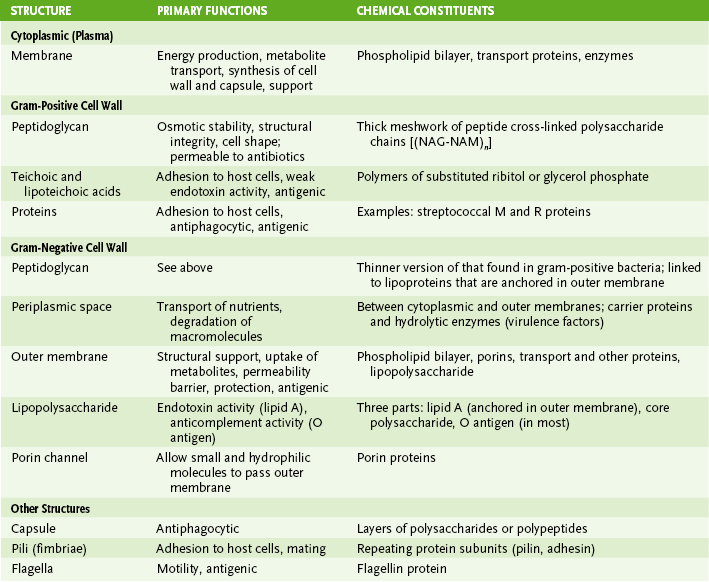Chapter 6 • Their cells lack nuclei and organelles, which distinguish them from the “true” cells of eukaryotes (i.e., algae, fungi, protozoa, plants, and animals). 2. The differences between eukaryotic and prokaryotic cells, summarized in Table 6-1, are the basis for antimicrobial drugs. TABLE 6-1 Prokaryotic Versus Eukaryotic Cells *Include mitochondria, Golgi complex, and endoplasmic reticulum. 1. Bacterial cells range from 0.2 μm (e.g., Mycoplasma species) to 3 μm (e.g., Bacillus anthracis) in diameter. 2. The ubiquitous Escherichia coli is about 1 μm in diameter. By comparison, erythrocytes are 8 μm in diameter. C Shape and arrangement of common bacteria (Fig. 6-1) 1. Distinguishes two major classes of bacteria (see Chapter 8) 2. Bacteria that have been starved or treated with antibiotics exhibit variable staining. 3. Gram-positive bacteria have a thick cell wall and stain purple. 4. Gram-negative bacteria have a thin cell wall and stain red. 5. Gram-resistant bacteria (e.g., Mycobacterium and Mycoplasma species) stain poorly or not at all with Gram stain. • Gram-positive and gram-negative bacteria have similar internal structures but structurally dissimilar cell envelopes (Fig. 6-2; Table 6-2). A Internal bacterial structures 1. Nucleoid is the central region of bacterium that contains DNA. 2. Bacterial cells contain a single chromosome composed of a circular DNA molecule. 3. Because bacteria lack a nuclear membrane, transcription and translation are coupled (i.e., ribosome-mediated protein synthesis can begin while a messenger RNA [mRNA] is being produced and is still attached to the DNA). 4. Bacterial ribosomes differ in size, components, and shape from eukaryotic ribosomes and thus are a major target of antibiotic action. 5. Plasmids, which are small, circular fragments of extrachromosomal DNA, may be present and often carry antibiotic resistance genes. • Bacterial cell envelope = cytoplasmic membrane + cell wall 1. Cytoplasmic (cell, plasma) membrane • Is structurally similar to eukaryotic membranes but lacks sterols, except in some mycoplasmas • Membrane contains enzymes and other proteins that carry out energy production (e.g., electron transport chain, F1 adenosine triphosphatase), transport of nutrients (e.g., permeases), and synthesis of structural components. 2. Cell wall of gram-positive bacteria (Fig. 6-3A)
Bacterial Structure
Characteristic
Prokaryotic Cells
Eukaryotic Cells
Size (approximate) (μm)
0.5–3
>5
Cell wall
Complex structure composed of proteins, peptidoglycan, and lipids
Only in fungal and plant cells; composition differs from that of bacterial cell wall
Plasma (cytoplasmic) membrane
Contains no sterols (except in Mycoplasma species)
Contains sterols
Nuclear membrane
Absent
Present
Genome
Single, circular DNA molecule in nucleoid
Multiple, linear DNA molecules in nucleus
Organelles*
Absent
Present
Ribosomes
70S (50S + 30S subunits)
80S (60S + 40S subunits)
Cell division
Via binary fission
Via mitosis and meiosis
![]()
Stay updated, free articles. Join our Telegram channel

Full access? Get Clinical Tree












